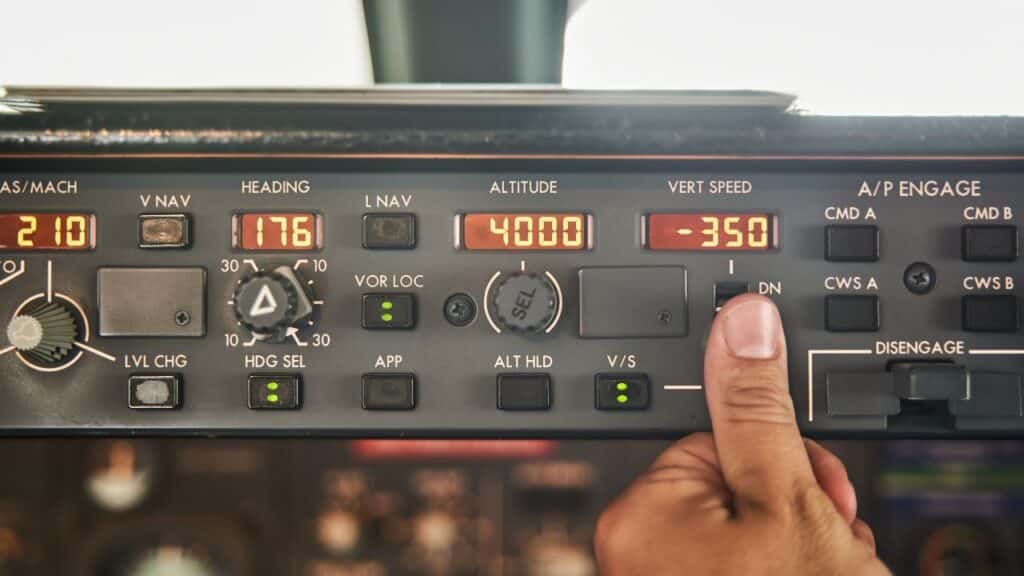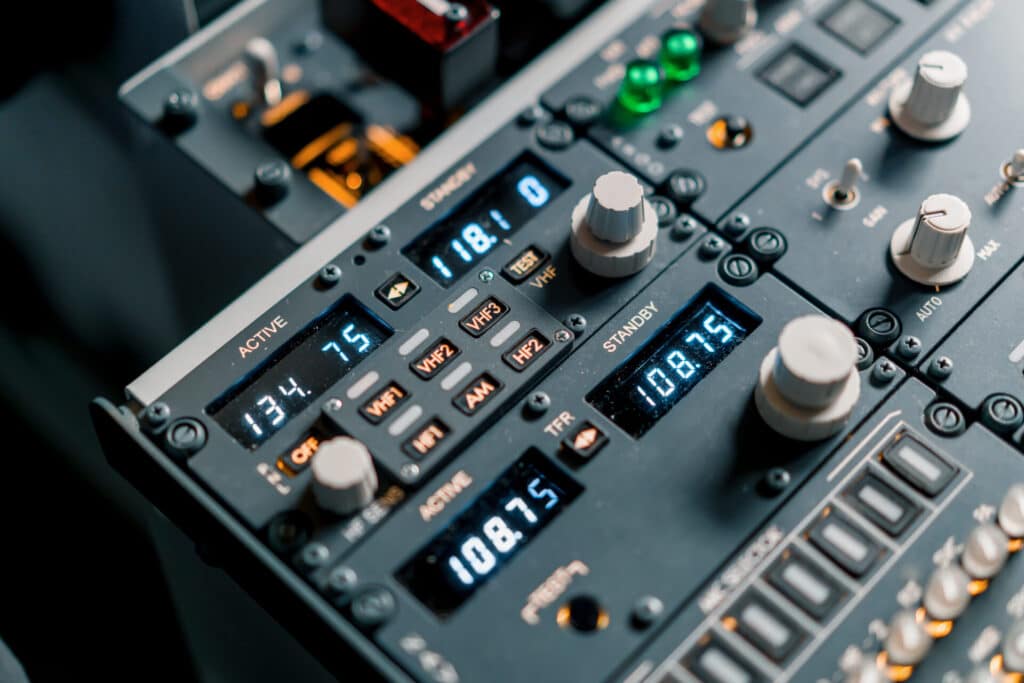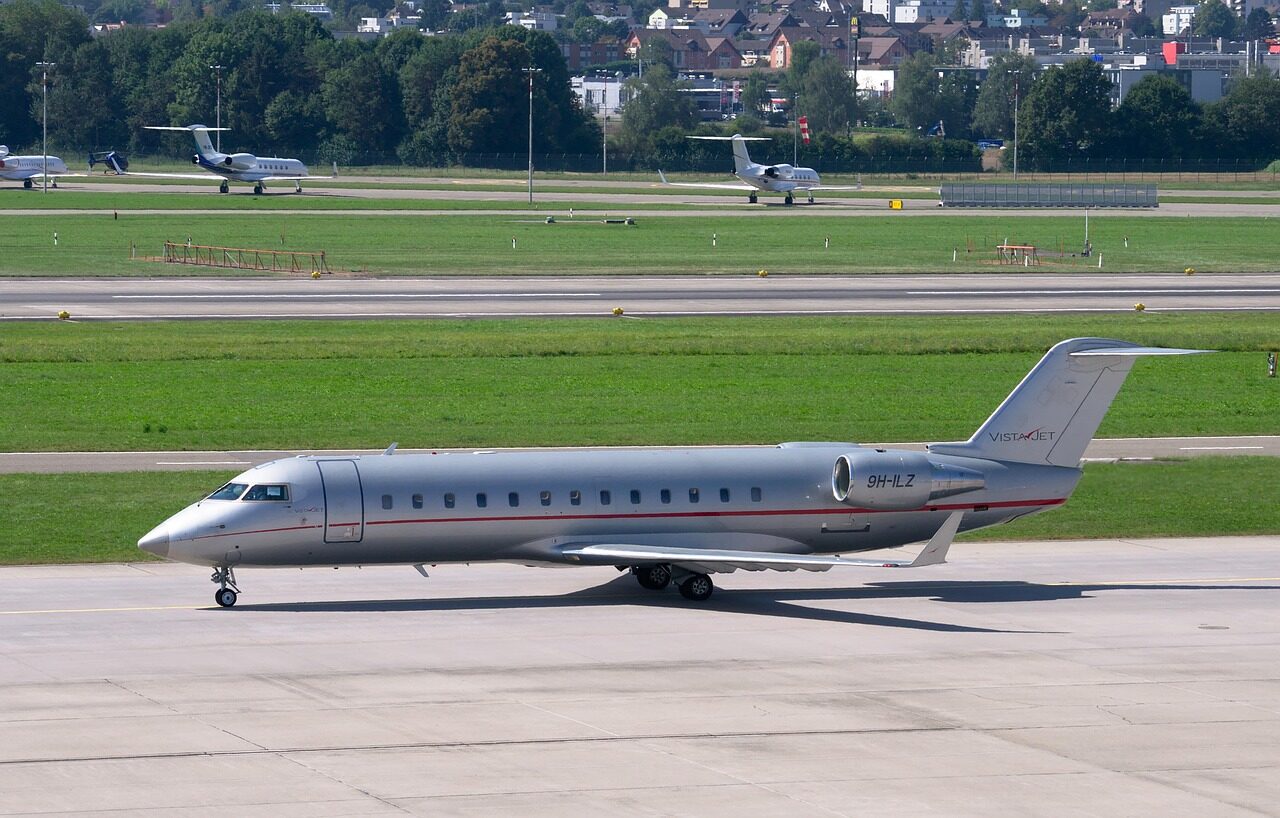Communication systems form the backbone of every Airbus A320 operation. From VHF radios that connect pilots to air traffic control to cabin interphone networks that coordinate emergency responses, these integrated systems ensure continuous situational awareness across all flight phases.
Disclaimer: This guide is for educational purposes only. For operational decision-making, always refer to your airline’s FCOM, QRH, and official Airbus documentation.
Emergency Electrical Configuration: Maintaining Critical Communications
When an aircraft enters emergency electrical configuration (EMER ELEC CONFIG), the communication capability reduces to essential minimums while ensuring flight safety remains uncompromised.
The system architecture prioritizes the following components:
VHF 1 radio remains powered, providing primary air-to-ground communication. RMP 1 stays operational for frequency selection and tuning. Both the Captain’s and First Officer’s ACPs (Audio Control Panels) remain functional, enabling crew coordination. The flight interphone continues working for cockpit-to-cabin communication. The Captain’s loudspeaker provides audio feedback for radio transmissions.
This redundant design guarantees that even in degraded electrical states, flight crews maintain the ability to communicate with ATC and coordinate within the cockpit. The configuration reflects Airbus’s commitment to fail-safe system design principles.

Radio Management Panel Architecture and Redundancy
The A320 features three Radio Management Panels that provide comprehensive control over communication transceivers.
RMP 1 and RMP 2 connect directly to all VHF and HF transceivers, offering primary control interfaces. RMP 3 accesses these same radios through RMP 1 and 2, creating a cascading redundancy structure.
Each RMP can control any transceiver in the aircraft. This architecture means that if one RMP fails, the remaining panels can still tune all radios without limitation.
Understanding the SEL Light Indication
The SEL (Select) indicator illuminates white on both RMPs when a transceiver is being controlled by a non-dedicated panel. For example:
- VHF 1 tuned by RMP 2 or RMP 3
- VHF 2 tuned by RMP 1 or RMP 3
- VHF 3, HF 1, or HF 2 tuned by RMP 1 or 2
This visual feedback helps pilots immediately understand which panel is actively controlling each transceiver.
Recovering from RMP Failures
When an RMP fails, the affected panel no longer controls the selected receiver. The frequency displays disappear and the green VHF or HF lights extinguish.
Recovery procedure: Switch the affected RMP to OFF position.
For a frozen RMP that won’t interchange ACTIVE and STBY frequencies, reset all RMPs sequentially. On each RMP Control Panel, switch ON/OFF to OFF, wait 5 seconds, then switch back to ON. This procedure resets the interconnected RMP network and typically restores normal operation.
VHF Communication Systems and ACARS
The A320 operates three VHF transceivers, each serving specific operational functions.
VHF 3 is primarily dedicated to ACARS (Aircraft Communications Addressing and Reporting System). This allocation ensures that operational data exchanges—including flight plans, weather updates, and loadsheets—remain uninterrupted by voice communication demands.
VHF 1 and VHF 2 handle standard air-to-ground voice communications with ATC. This separation between voice and data communications optimizes system performance and reduces frequency congestion.
Transmission Failure Protection
Airbus systems include automatic safeguards against stuck push-to-talk (PTT) switches.
If any PTT transmission selector remains jammed in transmit position for more than 30 seconds, the system automatically cuts transmission. An interrupted tone sounds for 5 seconds as an alert.
The ECAM displays:
- VHF 1 (2)(3) EMITTING or HF 1 (2) EMITTING
- Master Caution light illuminates
- Single chime sounds
This protection prevents continuous blocked frequency situations that could disrupt ATC communications.

HF Datalink Operations
High Frequency transmissions are normally inhibited on the ground to prevent interference. However, operational requirements sometimes necessitate pre-departure HF datalink messages.
By selecting the GND HF DATALINK OVRD pushbutton on the overhead panel, flight crews can bypass this ground inhibition. This allows HF datalink messages to be transmitted before departure when required by operational procedures.
Audio Control Panels and Intercom Systems
Each crew position has a dedicated Audio Control Panel that manages all audio inputs and outputs. These panels provide independent control over radio reception, interphone volume, and communication modes.

Service Interphone Override Function
The SVCE INT OVRD pushbutton enables communication with ground personnel regardless of landing gear status. When activated, the white ON light illuminates.
Ground personnel can communicate through this system via Service Interphone Jacks located around the aircraft. This function proves essential during maintenance operations, engine start procedures, and ground handling coordination.
Communication channels available through the Service Interphone System:
- Flight crew to Service Interphone Jacks
- Flight attendant stations to Service Interphone Jacks
- Inter-jack communication between different Service Interphone Jacks
Cabin Call Procedures
When cabin crew initiate a standard call to the cockpit, the ATT legend flashes green on the ACPs and a buzzer sounds. The ATT light automatically extinguishes after 60 seconds if the call remains unanswered.
For routine communication during flights, pilots select the MECH transmission key on the ACP and rotate the INT reception knob to communicate with cabin crew or ground personnel.
Emergency Call Systems
Emergency situations demand immediate, unmistakable communication protocols.
Cabin to Cockpit Emergency Calls
When cabin crew activate an emergency call:
In the cockpit, the white ON light and amber CALL light flash simultaneously. The amber ATT lights flash on both ACPs. Three long buzzers sound (inhibited during takeoff and landing phases).
In the cabin, “EMERGENCY CALL” displays on all Attendant Indication Panels.
The system resets automatically when the attendant hangs up the relevant handset.
Cockpit to Cabin Emergency Calls
When pilots initiate an emergency call to the cabin:
In the cabin, pink lights flash at all Area Call panels. “EMERGENCY CALL” appears on all Attendant Indication Panels. A high-low chime repeats three times through all loudspeakers.
In the cockpit, the ON light flashes white and the CALL light flashes amber.
This bidirectional emergency communication system ensures rapid coordination during time-critical situations. Learn more about emergency procedures in our guide to Airbus hydraulic systems.
Emergency Evacuation Signals
The EMER EVAC system provides distinct alerting patterns depending on initiation point.
Evacuation Initiated from Cockpit
When pilots activate the COMMAND pushbutton to ON:
On the overhead panel, the EVAC light flashes red and a horn sounds. In the cabin, EVAC lights flash at forward and aft attendant panels while evacuation tones sound throughout the passenger cabin.
Evacuation Initiated from Cabin
When cabin crew initiate evacuation with the CAPT & CAPT/PURS selector in CAPT position, only the cockpit horn sounds for 3 seconds. This limited alert allows cabin crew to initiate precautionary evacuation setup without immediately alarming passengers.
Audio Switching and ACP Backup
If an ACP fails, the Audio Switching Panel enables rerouting to maintain communication capability.
The switching panel offers three positions:
NORM – Each crew member uses dedicated communication equipment
CAPT 3 – Captain uses personal acoustic equipment with the third occupant’s ACP
F/O 3 – First Officer uses personal acoustic equipment with the third occupant’s ACP
When activated, “AUDIO 3 XFRD” appears in green on the ECAM MEMO display. This transfer removes the third occupant’s access to acoustic equipment but ensures primary crew positions maintain full communication capability.
Loudspeaker Volume Controls
The loudspeaker volume knob adjusts radio communication levels. This knob does not control aural alerts or voice messages, which maintain independent volume settings to ensure critical warnings remain audible regardless of communication volume preferences.
Cockpit Voice Recorder Operations
The CVR automatically records the last 2 hours of cockpit audio across all operational phases.
The recorder energizes automatically in three situations:
- During the first 5 minutes after electrical network energization (on ground)
- On ground with one engine running
- Throughout all flight phases
On the ground, crews can manually energize the CVR by pressing the GND CTL pushbutton.
CVR Testing Procedure
Before testing, ensure the parking brake is set to ON.
- RCDR GND CTL – Press to ON
- LOUDSPEAKER VOLUME KNOB – Set to OFF (both sides)
- ACP INT/RAD SWITCH (Captain or First Officer) – Set to INT
- INTERPHONE VOLUME RECEPTION KNOB – Release, then turn to maximum
- CVR TEST – Press and maintain
An audio test signal sounds through the loudspeakers, followed by a brief repetitive signal every 4 seconds. Use the hand microphone to speak and verify your voice is heard through the loudspeakers. Only release the CVR test pushbutton after voice confirmation.
Note: Use only the hand microphone during testing, not the boom microphone. This ensures proper audio signal routing through the loudspeaker system. Acoustic feedback during the test is normal and does not indicate a failed test.
Oxygen Mask Microphone Management
Fixed oxygen systems in the A320 cockpit include integrated microphones that activate automatically when masks are withdrawn from their stowage boxes.
After use, pressing the RESET control slide on the stowage box performs two functions: it cuts off oxygen flow and deactivates the mask microphone. This two-step safety design prevents accidental microphone activation and conserves oxygen when masks are not required.
CIDS Fault Implications
When CIDS 1+2 FAULT appears on ECAM after engine start, several passenger-facing systems become inoperative:
- Passenger Address system
- Cabin and Service Interphone
- Passenger signs (seatbelt, no smoking)
While this fault does not directly affect cockpit-to-ATC communication, it significantly restricts crew coordination with passengers and cabin crew. Crews must implement alternative communication procedures and consult MEL for dispatch implications.
PA Announcements
Public address announcements from the cockpit require minimal crew action. When using the cockpit handset for PA, no action is required on the ACPs. The system automatically routes the audio to cabin loudspeakers when the handset is lifted.
This simplified procedure allows pilots to make passenger announcements quickly without adjusting panel settings during critical flight phases.
Frequently Asked Questions
Which communication components remain available in emergency electrical configuration?
VHF 1, RMP 1, Captain’s ACP, First Officer’s ACP, flight interphone, and Captain’s loudspeaker maintain operation during EMER ELEC CONFIG.
What happens if a push-to-talk switch gets stuck?
After 30 seconds, the system automatically cuts transmission and triggers an interrupted tone for 5 seconds. The ECAM displays VHF EMITTING or HF EMITTING warnings.
Can all radios still be tuned if one RMP fails?
Yes. Each RMP can control all VHF and HF transceivers. If one RMP fails, the remaining panels maintain full tuning capability across all radios.
How long does the CVR record?
The Cockpit Voice Recorder stores the last 2 hours of cockpit audio.
What systems fail when CIDS 1+2 fault occurs?
Passenger Address system, Cabin and Service Interphone, and passenger signs become inoperative. Cockpit communication systems remain functional.
Can HF be transmitted on the ground?
HF transmission is normally inhibited on ground. The GND HF DATALINK OVRD pushbutton bypasses this inhibition when pre-departure HF datalink is required.
How do emergency calls from cabin differ from standard calls?
Emergency calls trigger flashing lights, repeated buzzers (three long tones), and “EMERGENCY CALL” displays. Standard calls show a green flashing ATT light with a single buzzer.
Conclusion
Airbus A320 communication systems exemplify aviation’s commitment to redundancy, clarity, and fail-safe operation. From the triple RMP architecture to automatic transmission cutoffs, every layer ensures that flight crews maintain situational awareness and coordination even in degraded modes.
Understanding these systems goes beyond passing type rating exams. It builds the operational competence that keeps flights safe when normal procedures break down and crew resource management becomes critical.
For additional technical resources on Airbus systems, explore our comprehensive library at The Flying Engineer. Master the fundamentals, understand the redundancies, and always cross-reference with your airline’s approved documentation.
Authors
-
Radu Balas: Author
Pioneering the intersection of technology and aviation, Radu transforms complex industry insights into actionable intelligence. With a decade of aerospace experience, he's not just observing the industry—he's actively shaping its future narrative through The Flying Engineer.
View all posts Founder
-
Cristina Danilet: Reviewer
A meticulous selector of top-tier aviation services, Cristina acts as the critical filter between exceptional companies and industry professionals. Her keen eye ensures that only the most innovative and reliable services find a home on The Flying Engineer platform.
View all posts Marketing Manager
-
Marius Stefan: Editor
The creative force behind The Flying Engineer's digital landscape, meticulously crafting the website's structure, navigation, and user experience. He ensures that every click, scroll, and interaction tells a compelling story about aviation, making complex information intuitive and engaging.
View all posts Digital Design Strategist


















